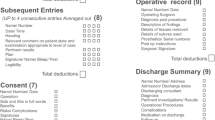Abstract
To discuss the importance of time and to introduce the concept of the time structured electronic patient record (EPR) in surgical oncology. An essay based upon the NC Misra Oration given to the Indian Association for Surgical Oncology National Conference in Lucknow, September 2011. The time structured EPR offers new insights into the contributions of multidisciplinary cancer therapeutic inputs to clinical outcomes. Indian surgical oncologists are well placed to lead in the application of modern information technology concepts to improve our understanding of cancer.


Similar content being viewed by others
References
Rew DA (2010) Development of the multidisciplinary team: the next steps. EJSO 36:221–223
Rew DA. Feature article: development of the multidisciplinary team in Breast Cancer. Advances in Breast Cancer December 2009, 1–3
Shneiderman B. The eyes have it: a task by data type taxonomy for information visualizations. Department of Computer Science, Human-Computer Interaction Laboratory, and Institute for Systems Research, University of Maryland July 1996. Source: citeseerx.ist.psu.edu/viewdoc/summary?doi=10.1.1.25.7925
Plaisant C, Mushlin R, Snyder A, Li J, Heller D, Shneiderman B. LifeLines: Using Visualization to Enhance Navigation and Analysis of Patient Records Revised version appeared in 1998 American Medical Informatic Association Annual Fall Symposium (Orlando, Nov. 9–11, 1998) AMIA, Bethesda MD, pp. 76–80
Lindwarm D., Rose, A., Plaisant, C., Norman, K. (May 1997). Viewing personal history records: A comparison of tabular format and graphical presentation using LifeLines. CS-TR-3795, UMIACS-TR-97-45. Revised version appeared in Behavior and Information Technology, 17, 5, 1998, 249–262. ncrr.nih.gov/publications/informatics/EHR.pdf accessed 27.08.2010
Marchionini G, Rimer BK, Wildemuth B. Evidence Base for Personal Health Record Usability: Final Report to the National Cancer Institute: University of North Carolina at Chapel Hill. February 10, 2007. Source Citeseer: ils.unc.edu/phr/files/finalreport010307.pdf
Hallett C, Power R and Scott D. Summarisation and Visualisation of e-Health Data Repositories. UK E-Science All-Hands Meeting, Nottingham, UK (2006). Source: informatics.sussex.ac.uk/users/drs22/projects/CLEF/publications/AHM06.pdf
Hallett C. Multi-modal presentation of medical histories, IUI '08: Proceedings of the 13th international conference on Intelligent user interfaces. 2008 pp. ACM–89.
Bui A, Aberle DR, Kangarloo H (2007) TimeLine: visualizing integrated patient records. IEEE Trans Inf Technol Biomed 11(4):462–473
Acknowledgement
This essay is based upon a lecture which was given to the National Conference of the Indian Association for Surgical Oncology at Lucknow in September 2011. It was delivered in honour of Prof NC Misra, MS FICS FACS FAMS FRCS, who worked at King George Medical College Lucknow from 1963 to 1996.
Professor Misra was a highly regarded teacher and surgical oncologist who was widely respected nationally and internationally. He won more than 25 professional awards and was academically prolific with more than 150 scientific papers. He had a broad clinical practice in the cancer surgical disciplines, and left a greatly respected legacy of family, colleagues, students and patients.
Author information
Authors and Affiliations
Corresponding author
Rights and permissions
About this article
Cite this article
Rew, D.A. Understanding Outcomes in Cancer Surgery Through Time Structured Patient Records. Indian J Surg Oncol 2, 265–270 (2011). https://doi.org/10.1007/s13193-012-0137-3
Received:
Accepted:
Published:
Issue Date:
DOI: https://doi.org/10.1007/s13193-012-0137-3




